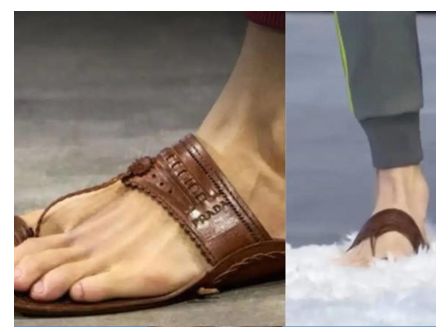- within Intellectual Property topic(s)
- in European Union
- with readers working within the Law Firm industries
- within Intellectual Property topic(s)
- in European Union
- in European Union
- in European Union
- with readers working within the Law Firm industries
- within Government, Public Sector, Energy and Natural Resources, Litigation and Mediation & Arbitration topic(s)
In recent years, global fashion houses have increasingly drawn inspiration from traditional Indian crafts and textiles. A recent talking point in the intellectual property (IP) and fashion law space is Italian luxury brand Prada's release of a footwear product strikingly similar to India's iconic Kolhapuri chappals. The move has sparked discussion, not just among fashion enthusiasts, but within the legal fraternity as well.
This intersection of fashion and intellectual property offers a unique opportunity to understand the limitations and potential of our existing legal framework.
What Are Kolhapuri Chappals?
Kolhapuri chappals are handcrafted leather sandals, traditionally made by artisans in Maharashtra and Karnataka. Known for their distinct design, durability, and craftsmanship, they are more than footwear as they represent a cultural legacy spanning over 800 years.
In 2019, Kolhapuri chappals were granted Geographical Indication (GI) status in India under the Geographical Indications of Goods (Registration and Protection) Act, 1999. The GI tag was meant to protect the artisan community and restrict misuse of the term "Kolhapuri" for products not made in the designated region or not conforming to the traditional technique.
What Did Prada Do?
At Prada's Spring/Summer 2026 showcase in Milan, Prada released a line of leather sandals that, by many accounts, resemble Kolhapuri chappals in both structure and aesthetic but without any explicit reference to India or the artisans behind the original design. The price is around 1.20 Lakh per pair.

At least seven of the 56 runway looks featured sandals that bear a striking resemblance to traditional Kolhapuris, complete with tan leather, thin straps, and toe rings. However, there was no mention of collaboration with Indian artisans, no acknowledgment of the craft's roots, and certainly no licensing arrangement involving the GI rights holders. The result: a traditional Indian product was repackaged as "luxury," while the original creators continue to struggle for fair compensation.
Is It a Legal Violation?
Here's where things get nuanced.
From the trademark law perspective, Prada did not use the word Kolhapuri, nor did they attempt to pass off their sandals as Indian-made. So, in the strictest sense, there may be no trademark infringement. However, this isn't merely a trademark issue as it's about cultural appropriation versus appreciation, and the broader need to reform how heritage crafts are protected globally.
From the GI law standpoint, India's GI tag does not automatically have extraterritorial effect unless the GI is registered or recognized in other jurisdictions (like the EU, where Prada is based). Even then, enforcement is challenging unless the misuse is textual or involves false origin claims.
The Broader Legal and Ethical Questions
- Is there a case for unfair competition or misrepresentation?
Possibly, if one can prove that the product's design is deceptively similar and causes consumer confusion. However, that bar is high in the absence of branding overlap.
- Can Indian artisans claim rights?
As GI rights are typically collective and territorial, a direct legal claim against Prada is difficult unless Prada falsely markets the product as Kolhapuri.
- Should Indian authorities pursue international GI registration?
Yes, extending protection through WIPO's Lisbon Agreement or bilateral treaties could give India better standing in future cases.
- What about moral rights or traditional knowledge?
Sadly, our current global IP regime does not adequately protect traditional craftsmanship unless it fits into established IP categories like design or GI.
The Way Forward:
While Prada's actions may not constitute clear violations of trademark or GI law, this incident underscores the urgent need for:
- Developing stronger international frameworks to protect traditional knowledge and craftsmanship.
- Promoting strategic branding and export initiatives to elevate heritage products like Kolhapuris.
- Establishing collaborative models where global brands work jointly with local artisans, ensuring respect for cultural origins and fair compensation.
This case highlights the importance of rethinking how we protect and promote traditional crafts in a globalized fashion landscape, balancing innovation with respect for cultural heritage.
The content of this article is intended to provide a general guide to the subject matter. Specialist advice should be sought about your specific circumstances.


